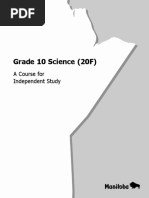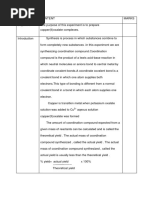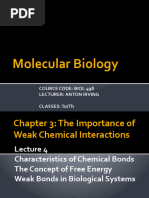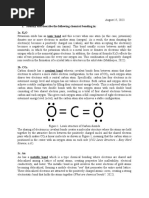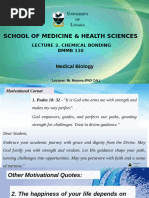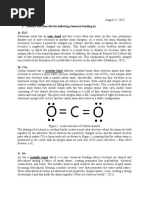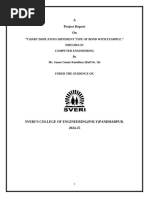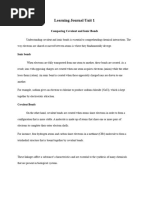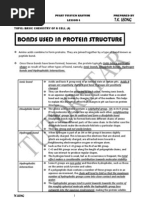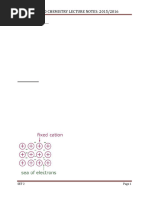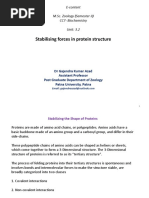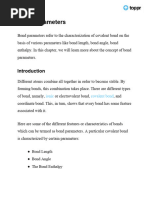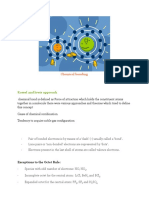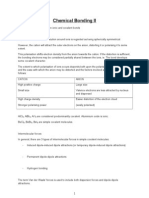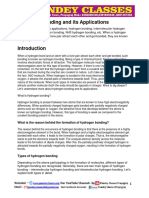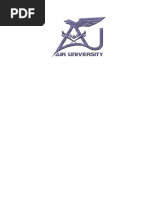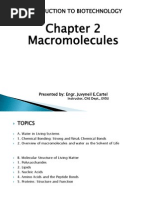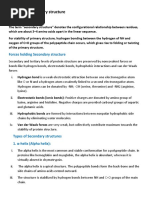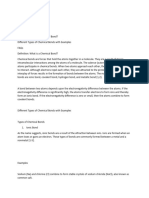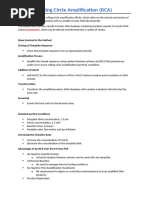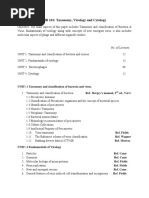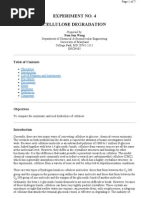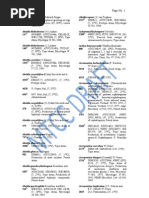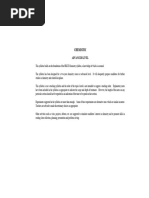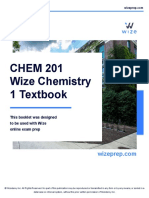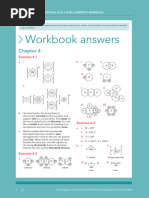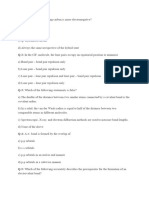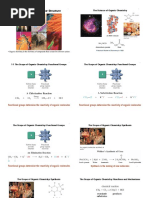0 ratings0% found this document useful (0 votes)
6 viewsBonds in Protein
Bonds in Protein
Uploaded by
Adena ClerisChemical Bonds in Proteins
Bascis of Protein
Basic study for protein engineering
Copyright:
© All Rights Reserved
Available Formats
Download as DOCX, PDF, TXT or read online from Scribd
Bonds in Protein
Bonds in Protein
Uploaded by
Adena Cleris0 ratings0% found this document useful (0 votes)
6 views4 pagesChemical Bonds in Proteins
Bascis of Protein
Basic study for protein engineering
Copyright
© © All Rights Reserved
Available Formats
DOCX, PDF, TXT or read online from Scribd
Share this document
Did you find this document useful?
Is this content inappropriate?
Chemical Bonds in Proteins
Bascis of Protein
Basic study for protein engineering
Copyright:
© All Rights Reserved
Available Formats
Download as DOCX, PDF, TXT or read online from Scribd
Download as docx, pdf, or txt
0 ratings0% found this document useful (0 votes)
6 views4 pagesBonds in Protein
Bonds in Protein
Uploaded by
Adena ClerisChemical Bonds in Proteins
Bascis of Protein
Basic study for protein engineering
Copyright:
© All Rights Reserved
Available Formats
Download as DOCX, PDF, TXT or read online from Scribd
Download as docx, pdf, or txt
You are on page 1of 4
Chemical Bonds in Proteins
Chemical bonds in proteins can be classified as:
Intramolecular Bonding: Bonds within a single protein molecule.
Intermolecular Bonding: Bonds between different protein molecules.
Covalent Bonds
Covalent bonds are formed by the sharing of electrons between atoms.
There are two main types:
Non-Polar Covalent Bonds: Electrons are shared equally between atoms.
Polar Covalent Bonds: Electrons are attracted more to one atom than
the other.
Example:
A• + B• → A..B
Types of Covalent Bonds:
1. Single Bond: Sharing of one pair of electrons.
o Example: Cl• + Cl• → Cl₂ (Cl-Cl)
2. Double Bond: Sharing of two pairs of electrons.
o Example: O •• + O •• → O₂ (O=O)
3. Triple Bond: Sharing of three pairs of electrons.
o Example: N••• + N••• → N₂ (N≡N)
Covalent Bonds in Proteins:
Covalent bonds connect atoms within a single amino acid and between
amino acids in a protein chain.
Disulfide bonds (a type of covalent bond) are formed between cysteine
side chains.
o These bonds are strong and not easily broken without denaturing
agents.
o Disulfide bonds contribute significantly to the three-dimensional
structure of proteins.
Protein Engineering Example:
Disulfide bonds can be added to proteins through site-directed
mutagenesis to increase thermal stability.
T4 Lysozyme: Incorporation of disulfide bonds can either increase or
decrease stability.
o Stabilization is due to reduced conformational entropy in the
unfolded state.
o Destabilization is often due to the introduction of dihedral angle
stress.
o Natural proteins may not tolerate disulfide bonds in most positions
without constraint on the α-carbon chain.
Ionic Bonds
Ionic bonds are formed through electrostatic attraction between oppositely
charged ions.
Example: Na⁺ + Cl⁻ → NaCl
In proteins, ionic bonds (or salt linkages) form between charged R groups
of amino acids within a polypeptide chain.
Example: The carboxylate group (RCOO⁻) of aspartic or glutamic acid can
interact with the ammonium group (RNH₃⁺) of lysine, arginine, or
histidine.
o Effective distance: Less than 4Å
Disruption of ionic bonds can significantly affect protein stability.
Protein Engineering Example:
In T4 lysozyme, disrupting the salt bridge between His 31 and Asp 70
through mutation results in destabilization (31-21 kJ/mol).
Hydrogen Bonds
Hydrogen bonds form between a hydrogen atom covalently attached to an
electronegative atom (e.g., oxygen or nitrogen) and another electronegative
atom.
Characteristics of Hydrogen bonds:
o Stronger than van der Waals forces.
o Hydrogen bonds are highly directional and form straight bonds
between donor hydrogen and acceptor atoms.
o Specificity arises from complementary hydrogen donor and
acceptor groups.
The contribution of H is said to be minor in the stability of folded
protein because H-bonding interactions can also occur with water in the
unfolded protein.
Protein Engineering Example:
Studies on enzymes like barnase, ribonuclease T1, ribonuclease A,
lysozyme, cytochrome c, and myoglobin show that intramolecular H-
bonds can significantly stabilize proteins, rivaling the hydrophobic effect.
Van der Waals Attractive Forces
Van der Waals forces arise from induced electrical interactions between
closely approaching atoms or molecules.
Types include dipole-dipole, dipole-induced dipole, and induced dipole-
induced dipole interactions.
Individually weak but collectively significant within a molecule.
Protein Engineering Example:
Van der Waals forces play roles in protein-protein recognition, such as
antibody-antigen interactions, where complementary shapes yield
extensive van der Waals attractions.
Hydrophobic Interactions
Hydrophobic interactions result from water molecules' tendency to exclude
non-polar groups or molecules.
Water prefers interacting with itself, raising its entropy when non-polar
molecules are excluded.
Non-polar regions of biological molecules are often buried to avoid
aqueous environments.
Protein Engineering Example:
Hydrophobic interactions drive the clustering of non-polar molecules
and are crucial for the folding and stability of proteins.
Coordinate Bonds
Coordinate bonds (dative covalent bonds) involve electrons shared by atoms
coming from only one of the atoms.
Examples: NH₄⁺, AlCl₄⁻, H₃O⁺
Important in substances like hemoglobin and myoglobin.
Representation:
An arrow indicates that both electrons in the bond originate from a
single atom.
These notes provide a comprehensive understanding of the different types of
bonds involved in protein structure and how they relate to protein
engineering. For detailed examples and diagrams, refer to the provided
document.
You might also like
- Grade 10 Science 20FDocument774 pagesGrade 10 Science 20FBuddhija Rathnayake67% (3)
- Preparation of Copper II Oxalate ComplexDocument4 pagesPreparation of Copper II Oxalate ComplexWagner Zwicker100% (1)
- 2.bonds in BiomoleculesDocument32 pages2.bonds in Biomoleculesmnouma1612No ratings yet
- Chemical BondsDocument7 pagesChemical Bondsgamire9699No ratings yet
- Molecular Biology Lecture 4Document36 pagesMolecular Biology Lecture 4Anton IrvingNo ratings yet
- Almonte, Jaezelle V. (Biochem Homework)Document5 pagesAlmonte, Jaezelle V. (Biochem Homework)Jaezelle AlmonteNo ratings yet
- Lecture 2 BMMB 110 Chemical BondingDocument111 pagesLecture 2 BMMB 110 Chemical BondingPaidamoyo MlamboNo ratings yet
- Almonte, Jaezelle V. (Biochem Homework)Document5 pagesAlmonte, Jaezelle V. (Biochem Homework)Jaezelle AlmonteNo ratings yet
- 1637754924984_1637126727758_Non covalent Interactions_211203_100615Document24 pages1637754924984_1637126727758_Non covalent Interactions_211203_100615r7cvr2f567No ratings yet
- Chemical Bonding/ Macromolecules: Dr. BryanDocument72 pagesChemical Bonding/ Macromolecules: Dr. BryanAlisha WallerNo ratings yet
- BondsDocument10 pagesBondsTarsem GargNo ratings yet
- Nursing Study Guide On BIOCHEMISTRY (CHAPTER 2 WATER)Document10 pagesNursing Study Guide On BIOCHEMISTRY (CHAPTER 2 WATER)Arvin Kim QuibingcoNo ratings yet
- H-bondingDocument3 pagesH-bonding7843No ratings yet
- Microproject BCHDocument10 pagesMicroproject BCHSwapnaja KumbharNo ratings yet
- Class 6_2 (1) (1)Document33 pagesClass 6_2 (1) (1)pradhansnehasis382No ratings yet
- 1 JournalDocument4 pages1 Journalsayenshan0205No ratings yet
- Bonds Used in Protein Structure: T.K. LeongDocument7 pagesBonds Used in Protein Structure: T.K. LeongLeong Tai KuanNo ratings yet
- Hydrogen BondDocument1 pageHydrogen BondDairabiyObyNo ratings yet
- 1540442559P1M28Dr HariprasadchemicalBondsDocument9 pages1540442559P1M28Dr HariprasadchemicalBondskuruvaravi9502No ratings yet
- Bio Physics Unit 04 by Cool EducationDocument11 pagesBio Physics Unit 04 by Cool Educationijazaman79No ratings yet
- 02 SNSNSJDocument10 pages02 SNSNSJCeriseNo ratings yet
- Ali RazaDocument9 pagesAli Razarizwanbieber3No ratings yet
- Hydrogen Bond PDFDocument10 pagesHydrogen Bond PDFNaman SinghNo ratings yet
- Chemical BondingDocument17 pagesChemical BondingBikramNo ratings yet
- Introduction To Supramolecular ChemistryDocument17 pagesIntroduction To Supramolecular ChemistrySaidul Islam RupokNo ratings yet
- Sch 2120 set 2Document33 pagesSch 2120 set 2stevemutisya10No ratings yet
- StemnewtonDocument12 pagesStemnewtonRoi Vincent Cuaresma BlasNo ratings yet
- Chemical BondDocument18 pagesChemical BondAli AmmarNo ratings yet
- Chemical BondingDocument19 pagesChemical BondingNikhil BagalkotNo ratings yet
- Definition: What Is A Chemical Bond? Different Types of Chemical Bonds With Examples FaqsDocument33 pagesDefinition: What Is A Chemical Bond? Different Types of Chemical Bonds With Examples FaqsMedakayala Nagasravanthi 20PHD7125No ratings yet
- BIOMOL - Bonds-Involved-in-Protein-StructureDocument12 pagesBIOMOL - Bonds-Involved-in-Protein-StructureT. Lalitha SreeNo ratings yet
- Class04 ChemistryG12 Notes and HomeworkDocument58 pagesClass04 ChemistryG12 Notes and HomeworkAndy Rei KouNo ratings yet
- Biochemistry Sem 1Document20 pagesBiochemistry Sem 1baroque.nacNo ratings yet
- Stabilising Forces in Protein Structure: E-Content M.Sc. Zoology (Semester II) CC7-Biochemistry Unit: 3.2Document16 pagesStabilising Forces in Protein Structure: E-Content M.Sc. Zoology (Semester II) CC7-Biochemistry Unit: 3.2paresh kumar sahoo100% (1)
- Protein 1 1Document42 pagesProtein 1 1Hriddo Aznom AadNo ratings yet
- Bond ParametersDocument3 pagesBond ParametersQuenneBelocuraNo ratings yet
- Chapter 1 Bonding and Molecular Sructure I Chemical BondingDocument5 pagesChapter 1 Bonding and Molecular Sructure I Chemical BondingJonathan SaydeNo ratings yet
- CBSE Class 11 Chemistry Chapter 4 Chemical Bonding and Molecular Structure Revision NotesDocument68 pagesCBSE Class 11 Chemistry Chapter 4 Chemical Bonding and Molecular Structure Revision Notesthesnak.132001No ratings yet
- Dalal Organic Chemistry for MscDocument430 pagesDalal Organic Chemistry for Mscprachichhillar4No ratings yet
- Class Notes PDFDocument6 pagesClass Notes PDFSavitaNo ratings yet
- Chemical Bonds - IIDocument35 pagesChemical Bonds - IIVlado PolezinaNo ratings yet
- Chemical Bonding IIDocument7 pagesChemical Bonding IIdanielmahsaNo ratings yet
- POLYMER ASSIGNMENTDocument10 pagesPOLYMER ASSIGNMENTrizwanbieber3No ratings yet
- Application of Hydrogen BondingDocument37 pagesApplication of Hydrogen Bondingastroverse00No ratings yet
- Raja Sher Afgan 241765 Chemistry Assignment 1Document10 pagesRaja Sher Afgan 241765 Chemistry Assignment 1sherafganrajaNo ratings yet
- Chemical BondingDocument6 pagesChemical BondingfareehaNo ratings yet
- Chap 2 Macromolecules 120711Document93 pagesChap 2 Macromolecules 120711Re CarlNo ratings yet
- Lecture 3: Secondary StructureDocument9 pagesLecture 3: Secondary StructureMustafa AlkubisiNo ratings yet
- Figure of Towels Sewn and Velcroed Representing Bonds Between Hydrogen and Chlorine AtomsDocument12 pagesFigure of Towels Sewn and Velcroed Representing Bonds Between Hydrogen and Chlorine AtomsW Ayu DewiNo ratings yet
- Notes and Chapter Quiz Answers From BiologyDocument10 pagesNotes and Chapter Quiz Answers From BiologyDayn KirkseyNo ratings yet
- Lewis FormulaDocument33 pagesLewis FormulaLucia PesentiNo ratings yet
- Chemical BondingDocument38 pagesChemical BondingK.B. DillipNo ratings yet
- Chapter 1 2Document37 pagesChapter 1 2llayanodehNo ratings yet
- Chapter 2. Chemical Bonding and Molecular InteractionsDocument29 pagesChapter 2. Chemical Bonding and Molecular InteractionsEliNo ratings yet
- G4 BasayaDocument2 pagesG4 BasayaDawn BasayaNo ratings yet
- 11 Chemistry-Chemical Bonding and Molecular Struture - NotesDocument23 pages11 Chemistry-Chemical Bonding and Molecular Struture - NotesSumit MahatoNo ratings yet
- Types of Chemical BondsDocument6 pagesTypes of Chemical BondsjoeldpenosNo ratings yet
- By AdithyaDocument35 pagesBy AdithyaA SQUARE GAMING DEVIL L7ADILHYANo ratings yet
- Types of Intramolecular Forces of AttractionDocument5 pagesTypes of Intramolecular Forces of AttractionGrazielle AlmazanNo ratings yet
- Genomics and Proteomics (BIOT 3014) Unit 3Document35 pagesGenomics and Proteomics (BIOT 3014) Unit 3thakurak110304No ratings yet
- Ach 2101 Lesson 5Document19 pagesAch 2101 Lesson 5Lawrence MajaliwaNo ratings yet
- A-Level Chemistry Revision: Cheeky Revision ShortcutsFrom EverandA-Level Chemistry Revision: Cheeky Revision ShortcutsRating: 4 out of 5 stars4/5 (5)
- RCADocument2 pagesRCAAdena ClerisNo ratings yet
- Biocontrol of Insect PestsDocument8 pagesBiocontrol of Insect PestsAdena ClerisNo ratings yet
- Practical MICRODocument1 pagePractical MICROAdena ClerisNo ratings yet
- Question Paper ASCDocument1 pageQuestion Paper ASCAdena ClerisNo ratings yet
- Semester - IDocument10 pagesSemester - IAdena ClerisNo ratings yet
- Indo TunisiaDocument7 pagesIndo TunisiaAdena ClerisNo ratings yet
- Adhyapak Sahayak Grant-In-AidDocument5 pagesAdhyapak Sahayak Grant-In-AidAdena ClerisNo ratings yet
- 376 of The Best One-LinerDocument21 pages376 of The Best One-LinerAdena Cleris100% (6)
- Self Appraisal For Academic Performance Index (Api) Objectives: 1) To Be Aware of Self AppraisalDocument8 pagesSelf Appraisal For Academic Performance Index (Api) Objectives: 1) To Be Aware of Self AppraisalAdena ClerisNo ratings yet
- Experiment No. 4 Cellulose DegradationDocument7 pagesExperiment No. 4 Cellulose DegradationAdena ClerisNo ratings yet
- Nanoparticle Drugs: B M C B TDocument1 pageNanoparticle Drugs: B M C B TAdena ClerisNo ratings yet
- May 2013Document1 pageMay 2013Adena ClerisNo ratings yet
- Helicobacter EngDocument1 pageHelicobacter EngAdena ClerisNo ratings yet
- MTCC Fungi CatalogueDocument79 pagesMTCC Fungi Cataloguemicrobio07No ratings yet
- June 2013Document1 pageJune 2013Adena ClerisNo ratings yet
- General Trends in The Chemistry of P-Block ElementsDocument7 pagesGeneral Trends in The Chemistry of P-Block ElementsSharon Shymala LewisNo ratings yet
- 2004 Chem A-LevelDocument72 pages2004 Chem A-LevelLam ChristyNo ratings yet
- Electronegativitiy Worksheet - WELCHDocument5 pagesElectronegativitiy Worksheet - WELCHkamrynwelch1No ratings yet
- 2015 A Level P1Document12 pages2015 A Level P1Faith SeahNo ratings yet
- Chemistry Study Guide - Paper 2Document32 pagesChemistry Study Guide - Paper 2p.spendian-smchsNo ratings yet
- CHEM 201 Wize Chemistry 1 Textbook: This Booklet Was Designed To Be Used With Wize Online Exam PrepDocument28 pagesCHEM 201 Wize Chemistry 1 Textbook: This Booklet Was Designed To Be Used With Wize Online Exam Prepsamantha davidsonNo ratings yet
- 4 Chemical BondingDocument63 pages4 Chemical BondingArvin LiangdyNo ratings yet
- ? ?? Nomenclature Organizer TemplateDocument2 pages? ?? Nomenclature Organizer Template814556No ratings yet
- Periodic Table DPPDocument19 pagesPeriodic Table DPPUMA JoshiNo ratings yet
- Physical Sci 1 20.2Document114 pagesPhysical Sci 1 20.2ShaneShanley LagazonNo ratings yet
- Know The Name of The Elements and Compounds KimiaDocument73 pagesKnow The Name of The Elements and Compounds KimiaNova SinagaNo ratings yet
- SCI 9 3covalent BondDocument7 pagesSCI 9 3covalent BondRaymel HernandezNo ratings yet
- Writing Chemical Formulae For Covalent and Ionic CompoundsDocument24 pagesWriting Chemical Formulae For Covalent and Ionic CompoundsDanah OudahNo ratings yet
- Chapter 14 - Aromatic CompoundsDocument16 pagesChapter 14 - Aromatic CompoundsXavi1980No ratings yet
- Chemical Bonding (F Only)Document28 pagesChemical Bonding (F Only)Raju SinghNo ratings yet
- Chemistry SyllabusDocument86 pagesChemistry SyllabusveereshNo ratings yet
- Ch4 Answers Asal Chem WBDocument5 pagesCh4 Answers Asal Chem WBamelia.szygendaNo ratings yet
- Chemical BondingDocument27 pagesChemical BondingSachin Kumar50% (2)
- Unit 11Document19 pagesUnit 11anil.gelra5140No ratings yet
- Activity 4 Properties of SolidDocument6 pagesActivity 4 Properties of Solidjoninna monesNo ratings yet
- WCH02 - 01 - Que - 20190117 Unit 2Document24 pagesWCH02 - 01 - Que - 20190117 Unit 2Hamza Tahir IqbalNo ratings yet
- VSEPR Lecture NotesDocument54 pagesVSEPR Lecture Notess76wz579ryNo ratings yet
- Chemical Bonding and Molecular Structure WS1Document3 pagesChemical Bonding and Molecular Structure WS1Ananthakrishnan Tinneveli VNo ratings yet
- Bonding and Molecular Structure: The Science of Organic ChemistryDocument25 pagesBonding and Molecular Structure: The Science of Organic ChemistryÁnh Tuyết PhùngNo ratings yet
- Lesson PlanDocument47 pagesLesson PlanMuhammad WahajNo ratings yet
- Science and Engineering of Materials Solutions Manual PDFDocument271 pagesScience and Engineering of Materials Solutions Manual PDFVenkata Krishnan Gangadharan63% (8)
- CBLG 143 - 1Document105 pagesCBLG 143 - 1Zhang RuiNo ratings yet
- Solid State-Theory & ExerciseDocument34 pagesSolid State-Theory & ExerciseRaju SinghNo ratings yet
